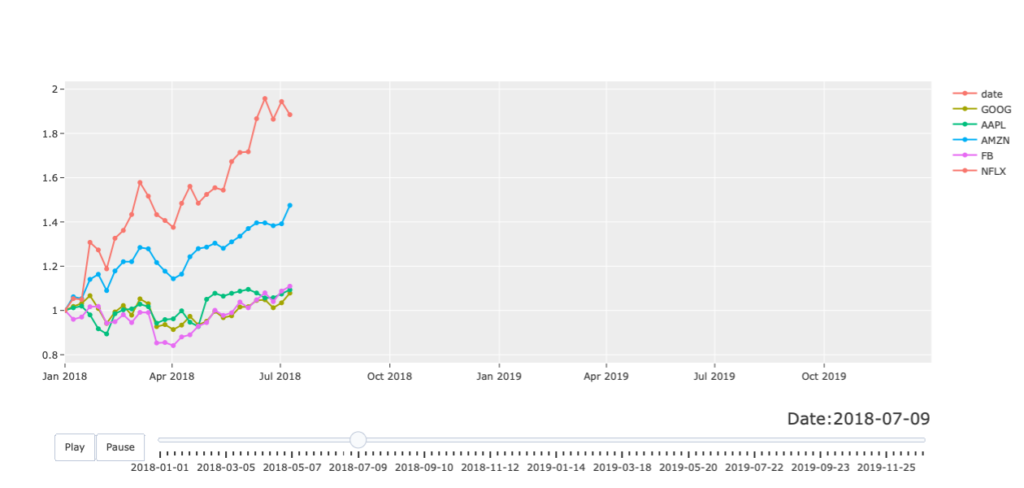Plotly Fundamentals -
Animations
Coming soon …
import pandas as pd
import plotly.express as px
import plotly.graph_objects as goComing soon …
df = px.data.gapminder()
fig= px.scatter(df, x="gdpPercap", y="lifeExp", animation_frame="year", animation_group="country",
size="pop", color="continent", hover_name="country",
log_x=True, size_max=55, range_x=[100,100000], range_y=[25,90], height=800)
fig.show()Coming soon …
fig = px.bar(df, x="continent", y="pop", color="continent",
animation_frame="year", animation_group="country", range_y=[0,4000000000], height=800)
fig.show()Coming soon …
stocks = px.data.stocks()
stocks.head()| date | GOOG | AAPL | AMZN | FB | NFLX | MSFT | |
|---|---|---|---|---|---|---|---|
| 0 | 2018-01-01 | 1.000000 | 1.000000 | 1.000000 | 1.000000 | 1.000000 | 1.000000 |
| 1 | 2018-01-08 | 1.018172 | 1.011943 | 1.061881 | 0.959968 | 1.053526 | 1.015988 |
| 2 | 2018-01-15 | 1.032008 | 1.019771 | 1.053240 | 0.970243 | 1.049860 | 1.020524 |
| 3 | 2018-01-22 | 1.066783 | 0.980057 | 1.140676 | 1.016858 | 1.307681 | 1.066561 |
| 4 | 2018-01-29 | 1.008773 | 0.917143 | 1.163374 | 1.018357 | 1.273537 | 1.040708 |
Coming soon …
dates = list(stocks['date'].unique())
stock_names = list(stocks.columns[1:])
#create empty figure
fig = go.Figure()
#prepare figure function input as python dictionary
fig_dict = {
"data": [],
"layout": {},
"frames": []
}
fig_dict["layout"]["updatemenus"] = [
{
"buttons": [
{
"args": [None, {"frame": {"duration": 100, "redraw": False},
"fromcurrent": True, "transition": {"duration": 100,
"easing": "elastic"}}],
"label": "Play",
"method": "animate"
},
{
"args": [[None], {"frame": {"duration": 0, "redraw": False}, #hack to drop animation
"mode": "immediate",
"transition": {"duration": 0}}],
"label": "Pause",
"method": "animate"
}
],
"direction": "left",
"pad": {"r": 10, "t": 87},
"showactive": False,
"type": "buttons",
"x": 0.1,
"xanchor": "right",
"y": 0,
"yanchor": "top"
}
]
#perpare slider dictionary
sliders_dict = {
"active": 0,
"yanchor": "top",
"xanchor": "left",
"currentvalue": {
"font": {"size": 20},
"prefix": "Date:",
"visible": True,
"xanchor": "right"
},
"transition": {"duration": 100, "easing": "elastic"},
"pad": {"b": 10, "t": 50},
"len": 0.9,
"x": 0.1,
"y": 0,
"steps": []
}
#create one trace for each stock that only shows first data point for first date (Initital Value)
for stock in stock_names:
data_dict = {
"x": dates,
"y": stocks[stock][stocks['date']==dates[0]],
'name':stock,
'mode': 'lines+markers'
}
fig_dict["data"].append(data_dict)
#loop through each date and add successively one data point for each stock and save in frame
for date in dates:
frame = {"data": [], "name": str(date)} #frame is same plot as initial value (one per date)
for stock in stocks:
data_dict = {
"x": dates,
"y": stocks[stock][stocks['date']<=date],
'name':stock,
'mode': 'lines+markers'
}
frame["data"].append(data_dict) #one trace per date per stock
#for each date save frame in fig dictionary and create slider step
fig_dict["frames"].append(frame)
slider_step = {"args": [
[date],
{"frame": {"duration": 100, "redraw": False},
"mode": "immediate",
"transition": {"duration": 100, 'easing': 'elastic'}}
],
"label": date,
"method": "animate"}
sliders_dict["steps"].append(slider_step)
fig_dict["layout"]["sliders"] = [sliders_dict]
fig = go.Figure(fig_dict)
fig.update_layout(xaxis_range =[dates[0], dates[-1]], height = 600)
fig.show()
